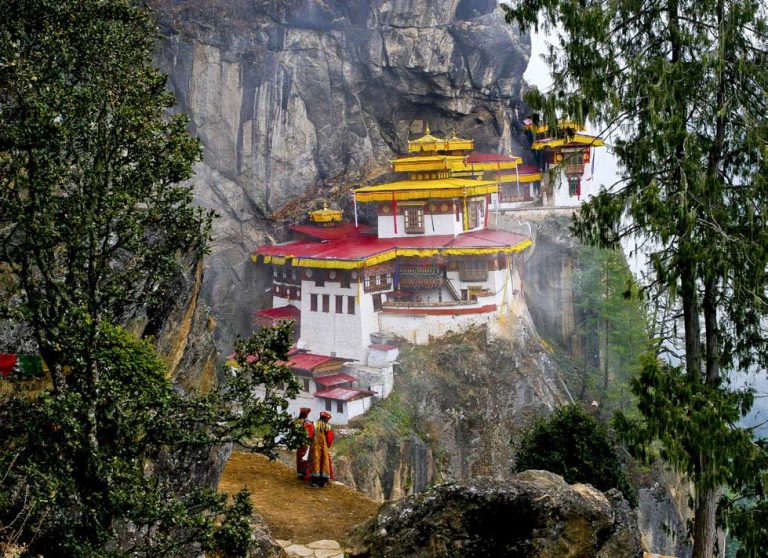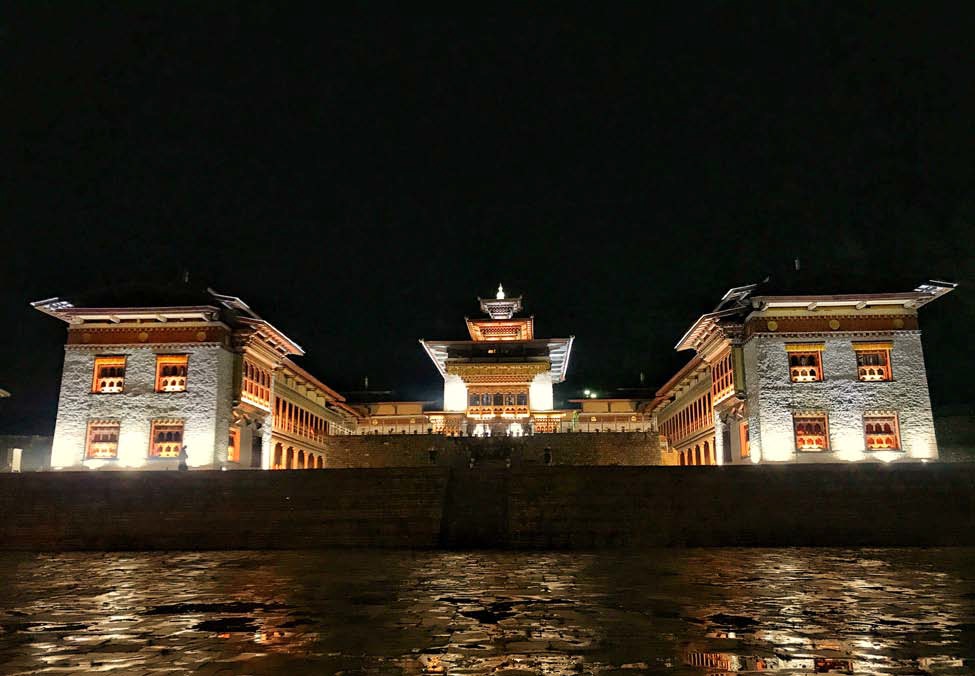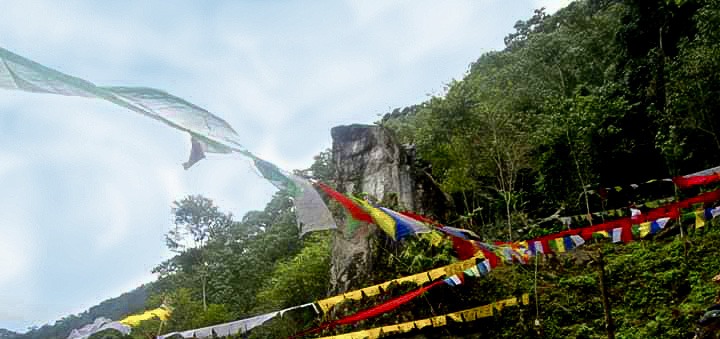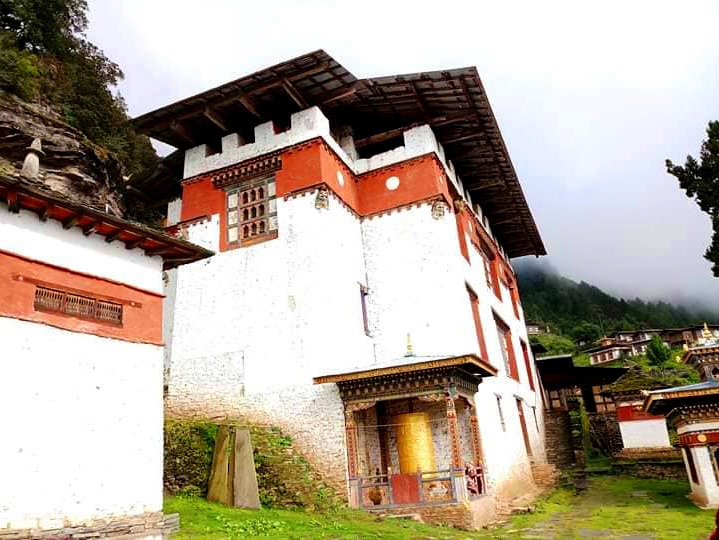THE BEST OF BHUTAN: 20 Iconic sites in the kingdom
Paro
Taktshang Monastery

Taktshang Monastery, famously called the Tiger’s Nest Monastery, precariously clings to a towering rock face, 2600 feet above Paro Valley. Taktshang is undoubtedly one of Bhutan’s architectural crown jewels and the most iconic Buddhist monument in the Himalayan Buddhist world.
Legend has it that in the eighth century, the great tantric master Guru Padmasambhava flew on a tigress to the cliff and meditated there for three months, subduing evil spirits in the locality.
The fourth temporal ruler of Bhutan, Druk Desi Gyalsey Tenzin Rabgye built a monastery on the site in 1692. The monastery was destroyed in a tragic fire on 19th April 1998. It was restored to its former glory by the Fourth King of Bhutan, His Majesty Jigme Singye Wangchuck.
Not only is Taktshang highly venerated by Buddhists all over the world, it is also a popular tourist attraction in the country. It takes about two hours hike to reach the monastery from the road point at Ramthangkha, 12 kilometers from Paro Town.
haa
Lhakhang Karpo
Lhakhang Karpo or the White Temple is located in the foothills of three towering mountains known as Rigsum Gonpo in the exotic Haa Valley, western Bhutan. Built in the 7th century by Tibetan King Songsten Gompo as part of the 108 temples built in the trans-Himalayan region in one day, Lhakhang Karpo is one of the oldest Buddhist temples in the country.
The White Temple derives its name from the white pigeon that was sent to scout the location for the construction of the temple. It is also believed that the temple was built by ‘people who suddenly appeared out of nowhere (Ha Tohm)”. The protective deity of Haa Valley, Ap Chundu is believed to have installed the main statue, Amitayus in the temple. Other relics include the statue of Tara, Vijaya, deity Chundu and holy Buddhist scriptures.
 The architectural grandeur of the temple is a true celebration of Bhutanese art. The interior of the Lhakhang is decorated with mural and paintings of great Buddhist saints, deities, and masters. Lhakhang Karpo was reconstructed in 2017 and today houses the monk body of Haa Dzongkhag.
The architectural grandeur of the temple is a true celebration of Bhutanese art. The interior of the Lhakhang is decorated with mural and paintings of great Buddhist saints, deities, and masters. Lhakhang Karpo was reconstructed in 2017 and today houses the monk body of Haa Dzongkhag.
Dagana
Dow Namkhai Kow

Dow Namkhai Kow or the Rock Sky Pillar is a huge stone megalith, about 20 meters high, located in Dagana. Legend has it that when the Daga Trashiyangtse Dzong was being constructed, the megalith is said to have emitted telepathic messages to the builders that the Dzong would collapse if it were built any taller than the pillar. Today, the tip of the pillar and the sertog (gilded cuppola) of the Dzong are of the same height. The other two rock pillars are Do Kelpai Genthey – The Rock of Ancient Steps, and Tha Namkhai Dzong – The Frontier Sky Fortress. These three rock pillars are believed to form a larger tripod.

SARPANG
Phibsoo Wildlife Sanctuary

Although the smallest of the 10 national parks in Bhutan with a total area of 269 square kilometers, Phibsoo Wildlife Sanctuary is one of the richest biodiversity hotspots in the country. Located in the foothills of south central Bhutan, covering Sarpang and Dagana Dzongkhags, the Wildlife Sanctuary has sub-tropical forest ecosystem, boasting approximately 1,259 acres of plantations. It was established as Phibsoo Reserved Forests in 1974 and upgraded to Wildlife Sanctuary in 1993.
Phibsoo Wildlife Sanctuary is home to Asiatic elephant, guar, endangered golden langur, pygmy hog and all the eight cat species. It is also the only natural habitat of spotted deer (Chital) and wild sal and agar wood forest in the country. Recently, the globally engendered white-bellied heron has been spotted along Phibsoo river and Longa river. The Sanctuary is home to around 637 species of flowering plants, 28 species of mammals and 132 species of birds.
TSIRANG
Pemachoeling Heritage Forest

Pemachoeling Heritage Forest in Tsirang encapsulates the vegetation surrounding the ruins of Tsirang Dzong (fortress) and Nye, a sacred site. It is believed that a powerful local chieftain called Sang Sup Gyalp built the Dzong in the 18th century. The chieftain also built a chorten atop the hill, which is considered a Nye. It takes a 20-minute hike from Pemaachoeling Heritage Forest to reach the Nye.
During holy days, local people visit the sacred site. Locals also believe that during auspicious occasions, the sound of religious trumpets would be heard emanating from the Nye site. However, this stopped after one of the bells at the Nye flew to Thasa Village in Dagana, where the bell hangs on a cliff even today.
Besides the religious and historical significance
Bumthang
Wangduechoeling Palace

The Palace of Wangduechoeling in Bumthang Valley is the birthplace of the first King of Bhutan Gongsar Ugyen Wangchuck. The palace serves as an important landmark in the history of monarchy in Bhutan. Built in 1857, the palace is an extraordinary manifestation of traditional Bhutanese architecture and craftsmanship. The magnificent carvings and paintings on the façade of the palace, the frames of the timber windows, and the wall murals are being currently restored.
The palace also served as the summer residence of the second King. During winter, the entire Royal court would move to Kuenga Rabten Palace in Trongsa in a procession that took three days. Wangduechoeling Palace has been included among the list of endangered monuments in the world by the World Monuments Fund (WMF), a New Yorkbased non-profit organization that works to protect historic sites around the globe.
Chhukha
Tshamdrak Goemba

The 17th century Tshamdrak Goemba located in Chacha Village is one of the sacred monasteries in Chhukha. Founded by Lam Ngawang Drakpa, the great teacher of Gangtrul Tenzin Legpai Dondup, the monastery houses important relics such as the 100 ceremonial drums extracted from a Cypress tree and a large stone slab that is attributed to Ap Chundu, the guardian deity of Haa.
It is believed that a Tibetan master Drigung Chopa Rinpoche prophesied that his son, Drubthob Sangay, would visit Bhutan to establish his lineage. From Dagala, where he meditated, he saw a cliff at the base of a hill resembling a pile of holy scriptures. He chose the place as his meditation place and it came to be known as Tshamdrak (tsham – meditation; drak – cliff).
Dagana
Dow Namkhai Kow

Dow Namkhai Kow or the Rock Sky Pillar is a huge stone megalith, about 20 meters high, located in Dagana. Legend has it that when the Daga Trashiyangtse Dzong was being constructed, the megalith is said to have emitted telepathic messages to the builders that the Dzong would collapse if it were built any taller than the pillar. Today, the tip of the pillar and the sertog (gilded cuppola) of the Dzong are of the same height. The other two rock pillars are Do Kelpai Genthey – The Rock of Ancient Steps, and Tha Namkhai Dzong – The Frontier Sky Fortress. These three rock pillars are believed to form a larger tripod.

Gasa
Land of Happiness

Located in the extreme northwest of Bhutan, Gasa holds a significant place in the history of Bhutan as Zhabdrung Ngawang Namgyal came to Bhutan via Gasa in the early 17th century. The first Deb Raja of Bhutan, Tenzin Drugyel, also came from the well-known house of the Hobtsho Lams in Gasa. Although quite remote, with far-flung highland communities in the north, Gasa’s natural splendor is unrivaled.
Gasa Tashi Thongmon Dzong
The fortress of Gasa, locally known as Tashi Thongmon Dzong, stands tall on a hillock, surrounded by towering mountain peaks. The fortress served as a defending barrack in the 17th century. When Zhabdrung came to Bhutan via Gasa, he named the fortress after Tashi Thongmon monastery in Ralung, Tibet where he was recognized and enthroned as the Drukpa lineage holder, and the region’s first deity Tashi Thubar. The fortress’s architecture is unique with a semi-circular arch and three watch towers that are placed at strategic points. The Dzong houses many sacred artifacts. The beauty of the Dzong is heightened during clear days with a view of Mt. Gangboom.
Laya village
The idyllic highland village of Laya is located at an altitude of 3,800m on the northwestern front of Gasa, bordering the Tibetan plateaus. Layaps or the ethnic people of Laya have
preserved their arcane culture, traditions, costumes, and semi-nomadic way of life. Layaps celebrate Owlay festival, which takes place once in three years. The annual Royal Highland Festival is celebratedat Langothang in Laya. The festival celebrates the unique cultural heritage and legacy of the highland communities of Bhutan, attracting many visitors from within and outside the country.

Gasa Tshachu (Hot spring)
The hot springs at Gasa are situated close to the banks of the Mo Chhu River, now accessible with a road. Believed to have healing powers, the famed hot springs draw people from near and far, locals as well as tourists. The Tshachu has nine ponds with varying temperatures. There are also bathing facilities. In addition
LHUENTSE
Jigme Namgyal Nagtshang


Jigme Namgyal Nagtshang
The Jigme Namgyal Nagtshang is a towering structure standing on top of a hill overlooking the historically significant Dungkhar Choeje Nagtshang Lhakhang on the lower edge of the hill and Dungkar Village in Lhuentse. This 18th century Nagtshang was built by Pila Goenpo Wangyel and later rebuilt by his second son, Jigme Namgyal, the father of the first King of Bhutan, Gongsar Ugyen Wangchuck.
The Nagtshang is a fine example of traditional Bhutanese manor house and an embodiment of medieval Bhutanese architecture and craftsmanship that has been preserved even to this day. The Nagtshang is historically significant as the birthplace of Jigme Namgyal, the architect of united Bhutan. It was first known as Pila Nagtshang, then as Khetanbi Nagtshang, and today it is known as the Jigme Namgyal Nagtshang.
Jigme Namgyal was born to Pila Goenpo Wangyel and Sonam Pelzom of Dungkar Choeje in 1825. The Dungkar Choje originated from the descendants of Khedrup Kunga
Wangpo, the son of Terton Pema Lingpa. At the age of 15, Jigme Namgyal traveled toward Bumthang and Trongsa to seek his fortune. He started as a tozep, a retainer at the Trongsa Penlop’s court, and gradually rose up the ranks and eventually became the Trongsa Penlop. As Trongsa Penlop, Jigme Namgyal united the country and paved way for his son, Ugyen Wangchuck to become the first Hereditary King of Bhutan.
Dungkar Nagtshang
Dungkar Nagtshang, located on the lower edges of Jigme Namgyal Nagtshang, is the principal birthplace and the home of the Wangchuck Dynasty. The Nagtshang is believed to stand on the tip of a Dungkar (conch) shaped landscape. Today the Nagtshang is owned by Choeje Tobgay, a descendant of Dungkar Choeje. The Nagtshang houses many sacred relics (terma) discovered by the great Terton Pema Lingpa and Desi Tenzin Rabgay. Dungkar Tsechhu (terchham) is performed from 8-11th day of the 11th month of
MONGAR
Drametse Lhakhang
Founded in 1511 by Ani Chhoeten Zangmo, the grand daughter of Terton Pema Lingpa, Drametse Lhakhang in Mongar is one of the principal spiritual centers of Peling tradition of Buddhism in Bhutan. The monastery is known for its origin of the famous Drametse Ngachham, dance of drums of Drametse that has been recognized as a masterpiece of oral and intangible World Heritage by UNESCO in 2005.
Located 19-kilometers from the junction of Mongar-Trashigang national highway, Drametse Lhakhang houses important relics mainly Kudung (embalmed body) of Ani Chhoeten Zangmo, Kapali (human skull) of a Dakini with self-arisen mantra syllables Om Ah Hung, and the largest thongdrel (applique) of Terton Pema Lingpa.
A three-day annual Kangso Chhenmo (festival of Vajra dances and rituals) is held at the monastery on the 10th Bhutanese month. Hundreds of people from eastern Bhutan attend the festival to witness the sacred treasure Vajra dances revealed by Terton Pema Lingpa.



PEMA GATSHEL
Yongla Goenpa

Yongla Riwo Pelbar Dargeychhoeling Goenpa or the Pelri Goenpa, widely known today as Yongla Goenpa is one of the most historic and sacred monasteries in Pema Gatshel, eastern Bhutan. It is located on top of a mountain and as one travels over the national highway linking Samdrup Jongkhar to Trashigang, one can catch a glimpse of the temple from the junction at Tshelingore where the road diverts and leads to Pema Gatshel. From this junction, it is half an hour drive to the monastery.
Yongla Goenpa is believed to have been built by the 2nd Yongla Lam Dorji Jamtsho in 1736, a year after the death of Khedrup Jigme Kuendrol who identified, meditated and blessed this sacred place following the vision of his master Rigzin Jigme Lingpa (1729-1798), a great Tertoen and Nyingma master.
The monastery played a significant role in providing spiritual protection during the Duar War. The Trongsa Penlop Jigme Namgyel, father of the First King Gongsa Ugyen Wangchuck, used it as a base of operations to launch raids upon the British troops.
A total of 14 successive Lams and 3 Latshabs have served as the abbot of Yongla Gonpa. Besides, several Buddhist masters and luminaries have also blessed this sacred place in the past.
Unfortunately, the Goenpa was severely damaged by the earthquake that struck the country on 21st September 2009. Upon His Majesty’s command, the Goenpa has been restored to its former glory.
The monastery houses several sacred relics such as Phurpa (Vajrakilya which was brought by the founder of the Goenpa, Jigme Kuendrol), statue of Guru Dorje Drolo flanked by Hor-dro-Mak-sum (wrathful form of Guru) and Guru Nangse Zilnon. In the Goenkhang, the main protective deities include Ma-Za-Dham-Sum, Gyem-Chamdrel-Sum, Dheyon Zanpo and Kalyon Yongba.
The Goenpa holds annual Phurpai Dubchen on 2nd to 10th day of the 8th Bhutanese month, Dadrang Tshechu, Kurims and other religious activities.
Punakha
Pungthang Dewai Chhenpoi Phodrang
Punakha Dzong, also known as Pungthang Dewai Chhenpoi Phodrang – the Palace of Great Bliss – is built at the confluence of Pho Chhu and Mo Chhu in Punakha Valley. Built in 1637 by Zhabdrung Ngawang Namgyal, the unifier of Bhutan, Punakha Dzong is by far the grandest of all Dzongs in the country, the magnificence of its architecture unrivaled.
Punakha Dzong is 180m long and 72m wide and the utse (central tower) is six storeys high. The gold dome on the utse was built in 1676 by the temporal ruler of Bhutan Gyalsey Tenzin Rabgye.
It is the second oldest Dzong in Bhutan and it served as the capital and seat of the government until the 1950s. Punakha Dzong holds an important place in the history of Bhutan as all the Kings of Bhutan are crowned here. It is also the winter residence of the central monastic body.
Punakha Dzong houses the preserved remains of Zhabdrung Ngawang Namgyal in the Machhen Lhakhang, and the sacred relic, Ranjung Karsapani, a self-created image of Avalokiteswara that miraculously emerged from the vertebrae of Tsangpa Gyarey, the founder of the Drukpa School when he was cremated.

TRASHIGANG
Twin Valleys of Merak & Sakteng



The scenic pastoral valleys of Merak (3500m) and Sakteng (2800m), home to semi-nomadic Brokpa communities, are located in Trashigang in eastern Bhutan. Both these highland villages fall within the Sakteng Wildlife Sanctuary.
The people of Merak and Sakteng trace their ancestral roots to Tshona region in Southern Tibet. It is believed that they migrated to Bhutan in the 15th century after slaying a cruel Chieftain who ordered them to level a mountain that obstructed sunshine from his palace.
Unblemished by modernization, the Brokpas practice their age-old customs, fiercely guarding their traditional way of life. Unlike other Bhutanese, Brokpas wear their own unique costumes. Yak rearing is the main source of livelihood for the highlanders. The Brokpas still practice the dying
tradition of polyandry, with brothers sharing a wife. The Brokpas worship Aum Jomo as their protective deity, who is believed to reside in the mountain of Jomo Kukhar, about seven hours walk from Merak Village. Every Autumn the people of Merak celebrate a two-day festival in honor of Aum Jomo.
‘Yak Chham’ or dance of the yaks and Achhe Lhamo Chham are unique to the Brokpas. The people of Sakteng also perform the naked dance called ‘terchham’ on the 15th day of the fifth lunar month of the Bhutanese calendar. The tercham, also known as terkong chham, is performed once in three years to dispel misfortunes and ward off evil spirits.
Besides their rich native culture and tradition, Merak and Sakteng are also believed to be home to the mythical yeti, the abominable snowman.
THIMPHU
Buddha Dordenma

The statue of Buddha Dordenma sits atop a hill in Kuenselphodrang Nature Park, overlooking the southern entrance to Thimphu Valley, the capital of Bhutan. Measuring169 feet in height, it is one of the largest Buddha statues in the world.
The statue is made of bronze and gilded in gold. Around 125,000 miniature Buddha statues, each measuring 8-12 inches, are placed within the Buddha Dordenma statue. The statue was consecrated on 25th September 2015 to honor the 60th Birth Anniversary of His Majesty the Fourth King of Bhutan.
The construction of the Buddha statue fulfills an ancient prophecy of Guru Rinpoche dating back to the eighth century A.D that was discovered by Terton Dorji Lingpa after 672 years.
The Buddha Dordenma Statue, which is visible from three corners of Thimphu Valley, is a majestic architectural feat, exuding an aura of peace and tranquility. Hundreds of devotees visit this massive Buddhist monument every day, some prostrating in veneration and others circumambulating the statue to gain positive merit.
ZHEMGANG
Royal Manas

The Royal Manas National Park is the oldest national park in the country located in the south central foothills of Bhutan. It was designated as a wildlife sanctuary in 1966 and upgraded to a National Park in 1993. The Park shares its boundary with Indian Manas National Park in the south, and is connected by biological corridors to Jigme Singye Wangchuk National Park in the north-west, Phibsoo Wildlife Sanctuary in the south-west, Phrumsengla National Park in the northern center, and Jomotshangkha Wildlife Sanctuary in the south-east.
Covering an area of 1,057 square kilometers, the National Park is arguably one of the top biodiversity hotspots in the country. The National Park is home to 558 species of flora, 65
species of mammals, 489 species of birds, 60 species of fish and more than 180 species of butterfly.
Some of the exquisite wildlife found in the National Park are the Royal Bengal Tiger, Golden Langur, Pygmy Hog, One- horned Rhino, and Asiatic Wild Buffalo, among others. The Park is also home to critically endangered White-bellied Heron, White-rumped Vulture and Red-headed Vulture.
The Royal Manas National Park is an attractive tourist destination, offering distinct experiences such as wildlife safari, river rafting in the emerald Manas river, bird watching, hiking and cultural immersion in the remote communities of Kheng region.
TRONGSA
Trongsa Chhoetse Dzong
Spectacularly located on a ridge high above the rumbling Mangdechhu, Trongsa Chhoetse Dzong was the seat of power that controlled the central and eastern parts of Bhutan. Strategically located along the ancient east- west trade route, the Trongsa Penlops (governor) asserted authority over central and eastern Bhutan. The first two Kings of Bhutan ruled from Trongsa Dzong. Traditionally, even today the crown prince is installed as the Trongsa Penlop (governor) before acceding the Golden Throne.
Built in 1644, the Trongsa Dzong is the largest fortress in the country. The awe-inspiring structure has many levels
that slope down the contours of the hill, connected by long corridors, alleys, stone stairs, and cobbled courtyards.
Because of its size, design, and position, Trongsa Dzong is easily the most impressive Dzong in Bhutan. It is one of the most aesthetic and magnificent works of traditional Bhutanese architecture. The massive Dzong houses 23 different Lhakhangs, the monastic body, and the administrative office.
A five-day annual Trongsa Tshechu performed in December and January is the most popular festival held in the central courtyard of the Dzong.

SAMTSE
Shivalaya.Mandi

The Royal Manas National Park is the oldest national park in the country located in the south central foothills of Bhutan. It was designated as a wildlife sanctuary in 1966 and upgraded to a National Park in 1993. The Park shares its boundary with Indian Manas National Park in the south, and is connected by biological corridors to Jigme Singye Wangchuk National Park in the north-west, Phibsoo Wildlife Sanctuary in the south-west, Phrumsengla National Park in the northern center, and Jomotshangkha Wildlife Sanctuary in the south-east.
Covering an area of 1,057 square kilometers, the National Park is arguably one of the top biodiversity hotspots in the country. The National Park is home to 558 species of flora, 65
species of mammals, 489 species of birds, 60 species of fish and more than 180 species of butterfly.
Some of the exquisite wildlife found in the National Park are the Royal Bengal Tiger, Golden Langur, Pygmy Hog, One- horned Rhino, and Asiatic Wild Buffalo, among others. The Park is also home to critically endangered White-bellied Heron, White-rumped Vulture and Red-headed Vulture.
The Royal Manas National Park is an attractive tourist destination, offering distinct experiences such as wildlife safari, river rafting in the emerald Manas river, bird watching, hiking and cultural immersion in the remote communities of Kheng region.
SAMDRUP JONGKHAR
Chokyi Gyatso Institute
Located on a hilltop, 18KM away from Samdrup Jongkhar town, Chokyi Gyatso Institute in Dewathang is a monastic college (shedra) founded by Dzongsar Khyentse Rinpoche. It started as a small temple built by Dzongsar Khyentse Rinpoche’s maternal grandfather, the late Lama Sonam Zangpo. The monastery is unique both in terms of Buddhist architecture and the programs offered at the institute. While adhering to a time-tested traditional program, the monastery is a testing ground for some of Dzongsar Khyentse Rinpoche’s most forward-thinking innovations in monastic education.
In addition, the Chokyi Gyatso Institute is known for its outstanding commitment to conservation and community development. The monastery is one of the first to declare a Zero Waste policy, encouraging the
community to reconsider the habit of offering packaged biscuits and snacks, instead putting great value on traditional weaving, home-churned butter, locally grown organic vegetables.

